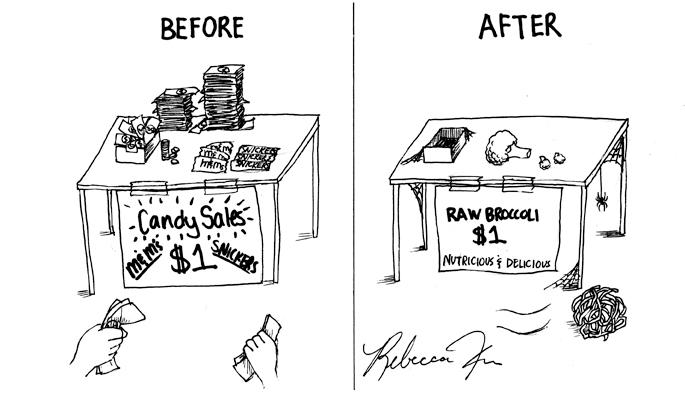 REBECCA XU / ART
REBECCA XU / ART
In a matter of weeks, the omnipresent plastic bags full of inexpensive candy should, in theory, disappear from this school’s hallways and classrooms. According to a new regulation, clubs will have to substitute their lucrative candy fundraising for something a little more on the healthy side. This presents a predicament for many clubs and activities, and it appears to be a problem not readily solved. While fundraising with “healthy food” is easily morally justified, it will fail to provide the amount of money generated from current fundraising operations.
The Hershey’s Fundraising motto states “America’s Best Loved Brands and Best Fundraising Value!” Fortunately for the company, the statistics don’t lie. According to the Hershey’s Web site, last year $40 million was generated for clubs, schools, churches and other businesses through Hershey’s fundraising. Of course, even this statistic barely scratches the surface of how lucrative candy fundraising really is.
The math makes sense. Put copious amounts of sleep-deprived and stressed teenagers in a high school for six hours every day, and they will use spare change to buy food. Whether it is out of hunger, exhaustion, anxiety or boredom, many find the simple pleasure of a candy bar to be a typical aspect of high school life. Generally speaking, most students would probably not scrounge in their pockets and wallets for a granola bar or dried fruit, thereby decreasing the profits for the clubs. These profits are essential for them to stay afloat and active in our consumer-driven and economically struggling society.
That is not to say that the new regulation doesn’t deserve some credit. According to Hershey’s Fundraising, the lowest caloric amount in a candy bar in their “Standard Bars” is 210. The traditional Hershey’s Bar, along with 210 calories, boasts 20 percent of the recommended daily amount of fat and 23 grams of sugar. These appalling numbers have unfortunately become the norm in our society, however, and there are few fundraising consumers that are unaware of the dangerous risk these sugar-coated treats impose on their bodies. Anymore, not only are candy fundraisers vital to the clubs that profit from them, they are a comforting normality for the students who consume them.
The credibility of this regulation also leaves questions. Although this state regulation was implemented in 2006, this school has chosen to delay beginning the program until now. With no consequences dealt to this school for thus far for not following the regulation, what are the benefits of hurting club funding today? Additionally, this school does not adequately represent the obesity of Indiana. The relatively low number of overweight students here does not compare to the 58.7 percent of overweight people statewide. There is little hope that this new regulation will at all decrease this sobering statistic.
Although selling T-shirts and other non-edible items may help supplement necessary costs for clubs, candy and bake sales have long been the bread and butter of a club’s existence. While regulating what can and cannot be sold to students is a great idea in theory, it fails to take into account the spending habits of teens. Candy fundraising began in the first place because it recognized exactly what students want between the arrival and dismissal bell, and nothing can financially replace the institution that is candy fundraising at this school.



















![Joseph Broman, Mu Alpha Theta sponsor, grades tests for his honors precalculus/trigonometry class. Broman said, “I’m retiring from the Math Club next year and I’m just going to do Mu Alpha Theta so I can focus on that one and we can do more [speaker series] first semester.”](https://hilite.org/wp-content/uploads/2024/03/IMG_9502-1200x900.jpg)











![British royalty are American celebrities [opinion]](https://hilite.org/wp-content/uploads/2024/03/Screenshot-2024-03-24-1.44.57-PM.png)




















![Review: “The Iron Claw” cannot get enough praise [MUSE]](https://hilite.org/wp-content/uploads/2024/04/unnamed.png)
![Review: “The Bear” sets an unbelievably high bar for future comedy shows [MUSE]](https://hilite.org/wp-content/uploads/2024/03/unnamed.png)
![Review: “Mysterious Lotus Casebook” is an amazing historical Chinese drama [MUSE]](https://hilite.org/wp-content/uploads/2024/03/0.webp)
![Thea Bendaly on her Instagram-run crochet shop [Biz Buzz]](https://hilite.org/wp-content/uploads/2024/03/IMG_0165-1200x838.jpg)
![Review: Sally Rooney’s “Normal People,” is the best book to read when you are in a time of change [MUSE]](https://hilite.org/wp-content/uploads/2024/03/20047217-low_res-normal-people.webp)
![Review in Print: Maripaz Villar brings a delightfully unique style to the world of WEBTOON [MUSE]](https://hilite.org/wp-content/uploads/2023/12/maripazcover-1200x960.jpg)
![Review: “The Sword of Kaigen” is a masterpiece [MUSE]](https://hilite.org/wp-content/uploads/2023/11/Screenshot-2023-11-26-201051.png)
![Review: Gateron Oil Kings, great linear switches, okay price [MUSE]](https://hilite.org/wp-content/uploads/2023/11/Screenshot-2023-11-26-200553.png)
![Review: “A Haunting in Venice” is a significant improvement from other Agatha Christie adaptations [MUSE]](https://hilite.org/wp-content/uploads/2023/11/e7ee2938a6d422669771bce6d8088521.jpg)
![Review: A Thanksgiving story from elementary school, still just as interesting [MUSE]](https://hilite.org/wp-content/uploads/2023/11/Screenshot-2023-11-26-195514-987x1200.png)
![Review: When I Fly Towards You, cute, uplifting youth drama [MUSE]](https://hilite.org/wp-content/uploads/2023/09/When-I-Fly-Towards-You-Chinese-drama.png)
![Postcards from Muse: Hawaii Travel Diary [MUSE]](https://hilite.org/wp-content/uploads/2023/09/My-project-1-1200x1200.jpg)
![Review: Ladybug & Cat Noir: The Movie, departure from original show [MUSE]](https://hilite.org/wp-content/uploads/2023/09/Ladybug__Cat_Noir_-_The_Movie_poster.jpg)
![Review in Print: Hidden Love is the cute, uplifting drama everyone needs [MUSE]](https://hilite.org/wp-content/uploads/2023/09/hiddenlovecover-e1693597208225-1030x1200.png)
![Review in Print: Heartstopper is the heartwarming queer romance we all need [MUSE]](https://hilite.org/wp-content/uploads/2023/08/museheartstoppercover-1200x654.png)























![Review: Ladybug & Cat Noir: The Movie, departure from original show [MUSE]](https://hilite.org/wp-content/uploads/2023/09/Ladybug__Cat_Noir_-_The_Movie_poster-221x300.jpg)

![Review: Next in Fashion season two survives changes, becomes a valuable pop culture artifact [MUSE]](https://hilite.org/wp-content/uploads/2023/03/Screen-Shot-2023-03-09-at-11.05.05-AM-300x214.png)
![Review: Is The Stormlight Archive worth it? [MUSE]](https://hilite.org/wp-content/uploads/2023/10/unnamed-1-184x300.png)

